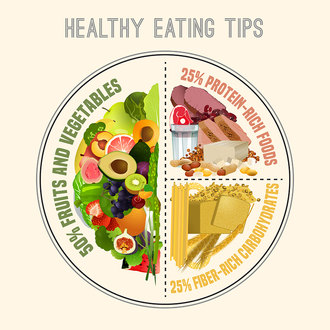Healthy Eating Tips
March is Nutrition Month, so take this time to take a step back and review your meals. Let's all ensure that we are eating balanced and nutritious meals every day!
Canada's Food Guide suggests that we eat a variety of healthy foods every day.
It's recommended that our meals are 50% plant-based, filling up on delicious fruits and/or vegetables. 25% with protein-rich foods and remaining 25% should be whole grains.
Fruits & Vegetables
Vegetables and fruits are an important part of a healthy eating pattern. Eating a variety of vegetables and fruits may lower your risk of heart disease.
Vegetables and fruits have important nutrients such as:
- fibre
- vitamins
- minerals
Include plenty of vegetables and fruits in your meals and snacks. Try making half of your plate vegetables and fruits.
Opt for different textures, colours and shapes to fit your taste. From apples to zucchini, choose plenty of vegetables and fruits. Try to avoid fruit juice and fruit juice concentrates as they are high in sugars. Replace juice with water. Choose whole or cut vegetables and fruits instead of juice.
Snack Ideas
Vegetables and fruits make quick and healthy snacks. There are lots to choose from and many healthy ways to prepare them. The key is to keep it easy and accessible! Keep a bowl of fresh fruit on the counter as an easy snack to grab and keep cut up fresh veggies in the fridge. Try broccoli, cauliflower, carrot sticks, celery sticks and cucumber slices.
Add fruit to whole grain cereals or lower fat yogurt. Try:
- bananas
- mangoes
- frozen berries
- canned peaches packed in water
- Freeze seedless grapes on a tray and enjoy them as a snack.
Protein
You can eat a variety of protein foods as part of a healthy eating pattern.
Choose protein foods that come from plants more often. Plant-based protein foods can provide more fibre and less saturated fat than other types of protein foods. This can be beneficial for your heart health.
You don’t need to eat large amounts of protein foods to meet your nutritional needs. Try to eat protein-rich foods such as:
- eggs
- lean meats and poultry
- nuts and seeds
- fish and shellfish
- lower fat dairy products
- beans, peas and lentils
- dried beans such as black beans and kidney beans
- fortified soy beverages, tofu, soybeans and other soy products
Here are some easy ways to eat more protein foods that come from plants:
- Add soft tofu to a blended soup to make it thicker and creamier.
- Try a bean salad, lentil and rice pilaf or a bowl of vegetarian chili for lunch.
- Make your own trail mix by combining your favourite whole grain cereal with a handful of nuts and seeds.
- Spread hummus on the inside of a whole grain pita and fill with vegetables such as romaine lettuce and shredded carrots.
Each week, plan a couple of meatless meals. As your main course, try using:
- beans in a burrito
- tofu in a vegetable stir-fry
- chickpeas and beans in tacos
- lentils in a soup, stew or casserole
Whole Grains
Whole grain foods are a healthier choice than refined grains because whole grain foods include all parts of the grain. Refined grains have some parts of the grain removed during processing.
Whole grain foods have more fibre than refined grains. Eating foods higher in fibre can help lower your risk of:
- stroke
- colon cancer
- heart disease
- type 2 diabetes
Enjoy a variety of whole grain foods such as:
- quinoa
- whole grain pasta
- whole grain bread
- whole oats or oatmeal
- whole grain brown or wild rice
For more information, visit https://food-guide.canada.ca/en/















